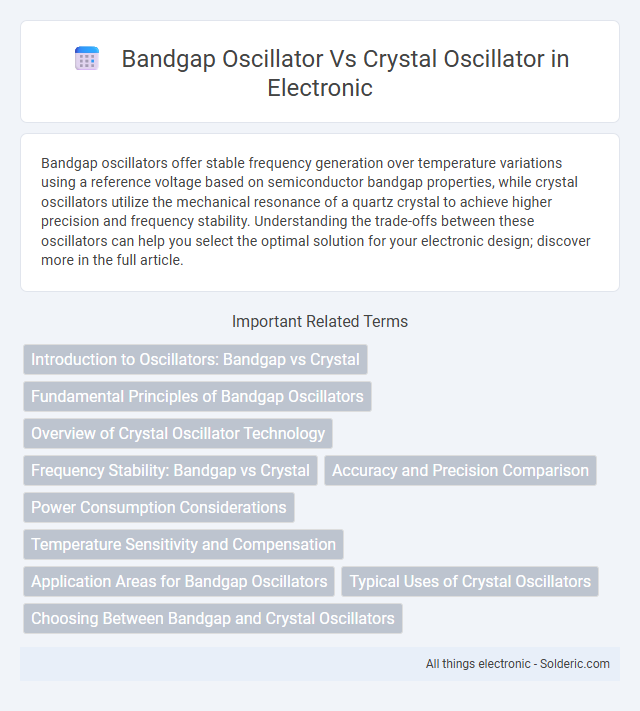Bandgap oscillators offer stable frequency generation over temperature variations using a reference voltage based on semiconductor bandgap properties, while crystal oscillators utilize the mechanical resonance of a quartz crystal to achieve higher precision and frequency stability. Understanding the trade-offs between these oscillators can help you select the optimal solution for your electronic design; discover more in the full article.
Comparison Table
| Feature | Bandgap Oscillator | Crystal Oscillator |
|---|---|---|
| Frequency Stability | Moderate, affected by temperature and supply variations | High, very stable over temperature and time |
| Frequency Range | Low to medium frequency (kHz to low MHz) | High precision frequencies (kHz to hundreds of MHz) |
| Size | Compact, integrated in ICs | Bulky due to crystal component |
| Power Consumption | Low to moderate | Low but depends on circuit configuration |
| Cost | Low cost, suitable for mass production | Higher cost due to crystal crystal |
| Applications | Clock generation in ICs, voltage reference circuits | Precise clock generation, communication, and timing devices |
| Temperature Sensitivity | Moderate sensitivity | Very low sensitivity |
Introduction to Oscillators: Bandgap vs Crystal
Bandgap oscillators generate stable voltage references by exploiting the temperature-independent bandgap voltage of semiconductor materials, making them ideal for integrated circuits requiring moderate frequency stability and low power consumption. Crystal oscillators rely on the mechanical resonance of a quartz crystal to produce highly precise and stable frequencies, essential for applications demanding superior timing accuracy and low phase noise. Your choice between bandgap and crystal oscillators depends on the required frequency precision, stability, and application-specific power constraints.
Fundamental Principles of Bandgap Oscillators
Bandgap oscillators operate based on the principle of creating a stable reference voltage by exploiting the predictable voltage difference between bipolar transistor junctions at a particular temperature, enabling low-frequency oscillations with minimal noise. This contrasts with crystal oscillators that utilize the mechanical resonance of quartz crystals to generate highly stable and precise frequencies. Bandgap oscillators are commonly preferred in integrated circuits for temperature compensation and low-power applications, where precise frequency control is less critical compared to crystal oscillators.
Overview of Crystal Oscillator Technology
Crystal oscillator technology relies on the piezoelectric properties of quartz crystals to generate highly stable and precise frequency signals, making them essential in applications requiring low phase noise and frequency accuracy. Unlike bandgap oscillators that use semiconductor junctions for frequency stabilization, crystal oscillators achieve frequency control through mechanical vibrations of the quartz crystal, resulting in superior long-term stability and temperature performance. This technology is widely utilized in communication systems, clocks, and microcontrollers due to its reliability and minimal frequency drift over time.
Frequency Stability: Bandgap vs Crystal
Crystal oscillators offer superior frequency stability compared to bandgap oscillators due to their reliance on quartz crystal resonance, which minimizes frequency drift caused by temperature variations and aging. Bandgap oscillators, while simpler and less costly, exhibit higher frequency deviation as their operation depends on semiconductor bandgap voltage, sensitive to temperature changes. Your choice of oscillator should consider that crystal oscillators provide precision timing essential in high-stability applications.
Accuracy and Precision Comparison
Bandgap oscillators offer moderate accuracy with frequency stability typically within a few percent, making them suitable for general-purpose timing applications. Crystal oscillators provide superior precision and accuracy, with frequency stability often better than +-10 ppm due to the high Q-factor of quartz crystals. The inherent frequency control of crystal oscillators enables precise timing in communication systems and high-performance electronics where exact frequency generation is critical.
Power Consumption Considerations
Bandgap oscillators generally consume less power compared to crystal oscillators due to their simpler circuitry and integration in low-power applications. Crystal oscillators, while offering superior frequency stability, require higher drive levels and consume more power because of the piezoelectric crystal's energy requirements. Designers prioritize bandgap oscillators for battery-powered devices where minimal power consumption is critical, whereas crystal oscillators are favored in precision timing applications despite their higher power usage.
Temperature Sensitivity and Compensation
Bandgap oscillators offer moderate temperature stability by relying on semiconductor junction voltage properties, with inherent compensation that reduces frequency drift over typical operating ranges. Crystal oscillators exhibit superior temperature sensitivity performance due to the piezoelectric quartz crystal's stable resonant frequency, often enhanced by temperature-controlled oven compensation (OCXO) or temperature-compensated crystal oscillators (TCXO) techniques. For applications demanding minimal frequency deviation under temperature variations, crystal oscillators provide more precise compensation and stability compared to bandgap oscillator designs.
Application Areas for Bandgap Oscillators
Bandgap oscillators are widely used in low-power communication devices, including RF circuits and sensor applications, where stable and precise voltage references are essential. These oscillators excel in integrated circuit applications, such as voltage regulators and analog-to-digital converters, due to their robustness against temperature variations and process fluctuations. Your choice of a bandgap oscillator ensures accurate frequency generation in compact, energy-efficient systems deployed in automotive electronics and portable gadgets.
Typical Uses of Crystal Oscillators
Crystal oscillators are primarily used in applications requiring high frequency stability and precision, such as in communication systems, clocks, and microprocessors. They serve as reliable frequency references for radio transmitters, GPS devices, and digital watches. Their ability to maintain a constant frequency over a wide temperature range makes them essential in timing-sensitive equipment and instrumentation.
Choosing Between Bandgap and Crystal Oscillators
Bandgap oscillators offer compact size, low power consumption, and robust temperature stability, making them ideal for integrated circuit applications requiring moderate frequency precision. Crystal oscillators provide superior frequency accuracy and long-term stability due to their quartz resonators, suitable for high-precision timing in communication systems and instrumentation. Selecting between bandgap and crystal oscillators depends on the application's frequency stability, size constraints, power budget, and cost considerations.
Bandgap oscillator vs Crystal oscillator Infographic

 solderic.com
solderic.com